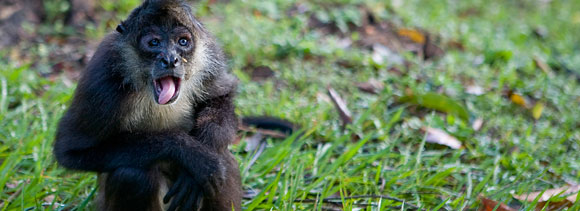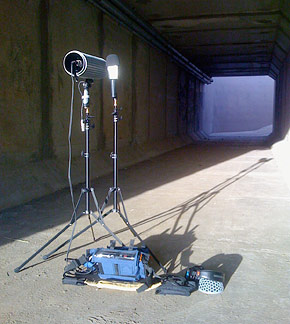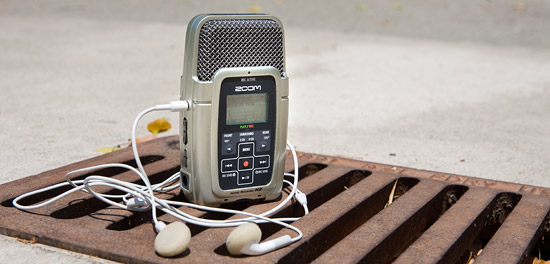Posted: July 8th, 2009 | Author: Nathan | Filed under: field recording, nature recording

This Belizean monkey despises you and your audio tomfoolery!
While staying in the Belizean jungle on vacation, I shoved my travel-worn Zoom H2 outside at the crack of dawn and let it run for a while. The jungle was simply alive with sound, and we were pretty far from any roads, so the recording was super clean and the birds were quite close by. Another great example of ensuring you have some sort of recording device – even if it’s not the best one – to capture such moments.
Apologies that I’ve not identified any species in this recording.
[soundcloud url=”http://api.soundcloud.com/tracks/5763755″ params=”show_comments=true&auto_play=false&color=ee0000″ width=”100%” height=”81″ ]
[Zoom H2, 90°-spread front mics]
Tags: field recording, nature, travel | No Comments »
Posted: July 7th, 2009 | Author: Nathan | Filed under: field recording, gear

Small photo light stands provide perfect mic support!
It’s always a struggle to take just enough with you into the field without being encumbered by gear that’s too heavy or too bulky, especially if you need to hike or schlep any appreciable distance to get to your location. My strategy is to ensure that everything I take with me is flexible, modular, and lightweight.
Being an avid photographer, I’ve been a longtime fan of David Hobby’s Strobist blog, where he focuses on maximum impact from incredibly portable equipment. Applying this knowledge to field recording has been not only easy, but some of the equipment can do double-duty. Hobby loves the Manfrotto 001B nano light stand (formerly the 3373) : It’s two pounds and collapses to 19″ in length. I’ve found it to be stellar for small flash units, so I decided to adopt it for audio recording as well.
I decided that the rest of my kit should be about the same length, as it fits perfectly in many bags that I own. I added a cheap On Stage telescoping mic boom, using a 3/8″ to 5/8″ adapter for mounting a pistol grip or windscreen, and a K-Tek KE-79 boompole. Finally, my Røde Blimp windscreen even fits into this range.
This kind of planning echoes some great backpacking advice I once got: buy your pack last, after you have everything else. All of these items now fit handily in a messenger bag or backpack, or you can even use bungee cords to strap it all together and throw it over your shoulder. Most importantly, though, they also fit inside most carry-on luggage. In high winds they might not be perfect, but I’m happy to sacrifice some weight for portability – besides, one can always weigh the stands down with one’s (now empty) bag, the field recorder itself, or your own fat arse.
The photo in this post features two Manfrotto 001B’s in a hyper-reverberant cow tunnel under Lucas Valley Road in Marin County, California…oddly enough, this is one of my favorite places to record (shown here at dawn, when there’s less traffic), and it’s about 1/4 mile away from world-famous Skywalker Sound. I set up my old Zoom H2 and a Røde NT4 stereo mic to compare their sounds. The NT4 (feeding into a Fostex FR2-LE,with which I had a tumultuous relationship) captured the crisp articulation of a rock being thrown in the tunnel (its original subtle phasing now lost to MP3 compression, sadly, but you’ll get the picture).
[soundcloud url=”http://api.soundcloud.com/tracks/5763727″ params=”show_comments=true&auto_play=false&color=ee0000″ width=”100%” height=”81″ ]
[Røde NT4 stereo microphone into Fostex FR2-LE field recorder]
Tags: audio equipment, digital audio, field recording | 4 Comments »
Posted: July 6th, 2009 | Author: Nathan | Filed under: field recording, found sound objects, sound design

This little device was surprisingly expressive.
Of course, the first thing a budding content gatherer does is to collect sounds and images around them, usually found in the home. Me, I went through power tools, my cats, rain outside, the toilet flushing…you name it, that day, it got committed to disk on my first recorder, the Zoom H2.
The thing that I discovered that made a great sound, that perhaps not everyone has lying around, is an immersion blender. Its variable speed dial made a nice sound even cooler once some speeds started resonating the plastic grip in a pretty insane way. Its tiny blades spun fast enough that they pushed a lot of air around, making for overly rumbly recordings near the business end. Ultimately, the best sound was where the shaft met the grip, mic perpendicular to the axis of the shaft.
Could it be used as a high-tech servo sound? Alien force field? A Mark V anti-gravity fargschnottle? Only further DSP can decide…
[soundcloud url=”http://api.soundcloud.com/tracks/5763710″ params=”show_comments=true&auto_play=false&color=ee0000″ width=”100%” height=”81″ ]
[Zoom H2, 90°-spread front mic pair]
Tags: digital audio, field recording, sound design | No Comments »
Posted: July 5th, 2009 | Author: Nathan | Filed under: field recording, gear, sound design
(Part 1 of a 3-part series: Part 2 | Part 3)
The ultimate rule of gathering, be it audio, photography, video, or butterflies, is this: The best tool in the world is the one you have with you. (Not sure who came up with this first, but I heard it initally from Chase Jarvis.)

The humble Zoom H2; even with higher-tech alternatives, still a viable tool.
My first dedicated audio recorder was the Samson Zoom H2, a cheap plastic box packed with four microphone capsules and a teensy screen. Its quirks and dull sound, however, are secondary to its pocket-sized form factor that lets you record stereo (or even semi-surround, using all four mics at once) literally anywhere. I’ve captured tons of sounds with the H2 that I’ve had missed if I carried more “serious” audio equipment with me (which I’ve since upgraded to, and you’ll read more about in the coming weeks).
One such example is this slice of urban ambience, replete with a heated street argument, shot out of a third-story window in San Francisco’s Mission District.
[soundcloud url=”http://api.soundcloud.com/tracks/5763682″ params=”show_comments=true&auto_play=false&color=ee0000″ width=”100%” height=”81″ ]
[Zoom H2, 120°-spread rear mic pair]
Tags: audio equipment, digital audio, field recording, sound design | No Comments »
Posted: July 4th, 2009 | Author: Nathan | Filed under: news
I so don’t know what I’m doing. And that’s what makes it great.

Welcome to Noise Jockey, where I, Nathan Moody, will be chronicling my journey (some would argue my “descent”) into the world of audio, field recording, music, sound effects, sound mixing, and more. I’m a digital creative professional who has skirted the world of audio for over a dozen years, and usually acts as the audio advocate of whatever visual (and usually interactive) project I’m working on.
Dabbling in field recording and sound is certainly less of a hobby or pasttime than playing or recording music, but I think it’s on the rise. The surge in online video certainly calls for more finessed approaches to sound for picture. The availability of insanely advanced audio hardware at low prices is truly ushering in a golden age of new sound gathering. Call me a semi-professional, or obsessed/advanced amateur, or a tourist, but I’m having a blast. And I figured it’s time to share, not just successes, but missteps and mishaps.
Noise Jockey will feature notes from the field, sound experiments, cool samples, stories, techniques, and music. You are hopefully interested in the same, and might find some interesting insights from a highly visual person moving towards the sonic arts.
Let’s kick things off with some silliness: Here’s a short piece I performed on a Casio Magical Sound Dial toy keyboard, multitracked in Logic Pro. The sound was captured from the keyboard’s single speaker by a complete piece of crap Shure microphone (plenty of higher-fidelity sound to come in the future, don’t worry). It’s simple, silly, and I just love the 8-bit, overdriven-speaker sound.
[soundcloud url=”http://api.soundcloud.com/tracks/5763611″ params=”show_comments=true&auto_play=false&color=ee0000″ width=”100%” height=”81″ ]
There is much more to come, so please stay tuned. Oh, and do feel free to also follow Noise Jockey on Twitter. Welcome!
Tags: digital audio, field recording, music, sound design, toy instrument | No Comments »




